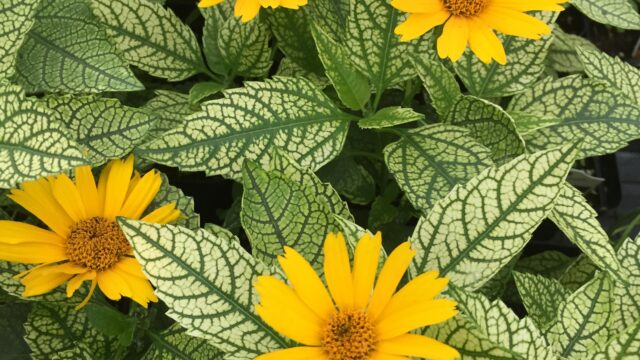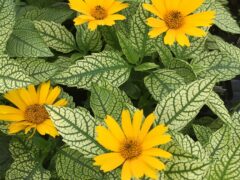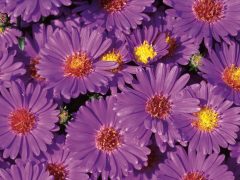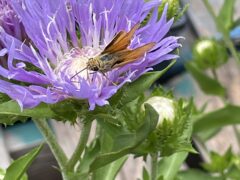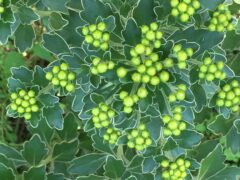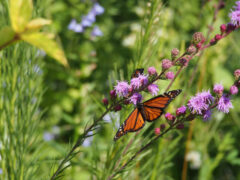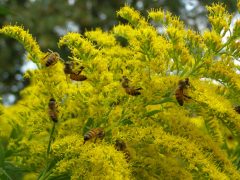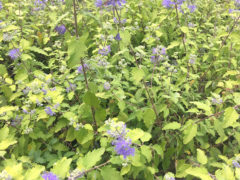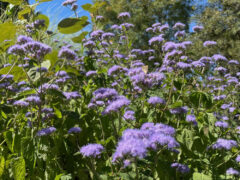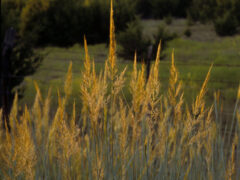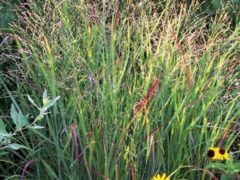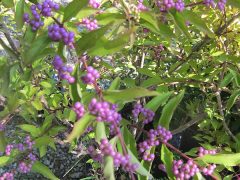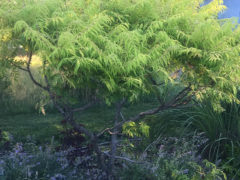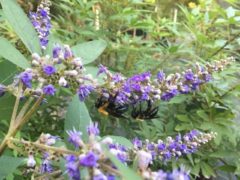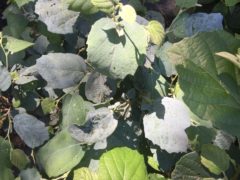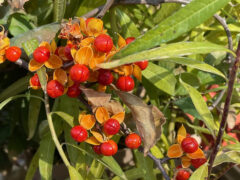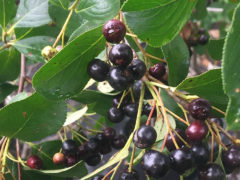In addition to mums, pansies, ornamental cabbage and kale, many hardy perennials and shrubs provide late-season food for pollinators, songbirds, and other wildlife while also adding colorful blooms and berries. Here are some of our favorites…
https://youtu.be/2AFFkNJk3Xg
Perennials for Late Season Bloom
‘Summer Sun’ & ‘Sunstruck’ false sunflower
Heliopsis helianthoides 'Summer Sun'/Heliopsis helianthoides var. scabra ‘Sunstruck’
'Summer Sun' is a long-blooming hardy perennial that produces yellow, semi-double daisy flowers with deep orange-yellow center disks all summer long. An excellent tall selection for the back of the border that looks fresh and happy even in the hottest weather, it will attract pollinators like crazy. Great for cutting.
‘Sunstruck’ grows with striking variegated foliage. A most attractive border plant even when not in flower. Covered with the same cheery, bright yellow daisies from summer thru fall.
SELECTION OF NATIVE.‘Wood’s Purple’ New York Aster
Symphyotrichum novi-belgii 'Wood's Purple'
New York aster is a low-maintenance perennial for average, medium moisture, well-drained soil in full sun. The Novi-belgii species is valued for its compact growth habit, rich flower color, and floriferous tendencies. 'Wood's Purple' flowers open over a long season, from late summer through fall. Low-maintenance, mildew-resistant, compact plants provide late-season nectar for pollinators. Selected for low-growing height, plants grow only 12" tall and wide. Symphyotrichum novi-belgii is a larval host plant for caterpillars of the pearl crescent (Phyciodes tharos).
‘Mel’s Blue’ Stoke’s aster
Stokesia laevis 'Mel's Blue’
Native to wetlands, bottomlands, savannas, and ditches along the coastal plain from North Carolina to Florida to Louisiana, Stokesia is evergreen in the south. It features fluffy, cornflower-like, violet-blue flowers 2 1/2” across from summer through fall. Easily grown in average, medium moisture, well-drained soil in full sun. Plants tolerate filtered sunlight but prefer full sun. Surprisingly good drought and heat tolerance, plants will not tolerate poorly drained soil in winter. 'Mel's Blue' was discovered in 2007 as a chance mutation of an unnamed variety of Stokesia laevis.
‘Gold and Silver’ chrysanthemum
Ajania pacifica 'Gold and Silver'
Superb, white-edged foliage with small, yellow flowers in late fall. An exceptional plant with striking foliage native to central and eastern Asia. It is a mound-forming, rhizomatous perennial noted for its striking variegated foliage in spring and summer. It typically forms a dense foliage mound to 18-24” tall that spreads over time by rhizomes to as much as 36” wide. Undersides of the leaves are silvery. Some gardeners grow this plant primarily for its foliage. Autumn bloom features small, button-like, yellow flower clusters.
meadow blazingstar
Liatris ligulistylis
A fantastic nectar plant for Monarch butterflies and many other pollinators including hummingbirds. The fall seeds are popular with Goldfinches. Grows up to 5' tall when planted in rich soils, in which case you may want to stake the plants. The color leans magenta, and tufted blossoms often appear all at once along the stems, lasting for many weeks in late summer.
‘Little Lemon’ dwarf goldenrod
Solidago canadensis ‘Little Lemon’
This native selection is a compact, upright plant growing only 18″ tall and produce dense, golden-yellow flower plumes in late summer and fall. Zone 4 NATIVE TO MOST OF NORTH AMERICA MINUS THE SOUTHEAST.
blue mist spirea, bluebeard
Caryopteris incana
This fragrant late summer bloomer sends up aromatic, whorled, blue-flowering spikes over striking bright chartruese foliage. A wonderful contrast plant that is adaptable to difficult sites and beautiful even when not in bloom. Root hardy to USDA zone 5 will die back to the ground in cold weather. An important late season pollinator nectar plant. ‘Worcester Gold’ is a cultivar with striking, bright golden-yellow foliage. 'Blue Myth' is a slightly more compact cultivar topping out at about 24-30" with dark blue flowers. ‘Dark Knight’ offers a reliable 24" height and spread.
hardy ageratum, blue mist flower
Conoclinium coelestinum
Intense blue flowers in summer are surrounded by glossy green foliage which turns vibrant scarlet in fall. It grows vigorously around other perennials and shrubs 6-10" high, offers pollinators a much-needed late-season food source, and has wonderful multi-season ornamental usefulness.
Indian grass
Sorghastrum nutans
Upright clumps of slender, blue-green leaves 1/2" wide. Foliage turns orange-yellow in fall. Stems are topped with feathery, light brown flower panicles 12" long highlighted with yellow. Panicles darken to chestnut brown in fall as they mature, later fading to gray. Panicles continue to provide interest well into winter. [gallery link="file" columns="1" size="medium" ids="6089"]
‘Shenandoah’ red switchgrass
Panicum virgatum ‘Shenandoah’
Best burgundy-red coloring of all the switch grasses. Deep-green foliage takes on red hues by midsummer. The coloring becomes more pronounced until it turns deep burgundy-wine by September. Tolerates a wide range of soil. NATIVE TO NORTH AMERICA MINUS WESTERN COASTAL STATES. [gallery link="file" columns="1" size="medium" ids="6089"]
Woody Plants for Fall & Early Winter Interest
American beautyberry
Callicarpa americana
A rounded, deciduous shrub with upright-arching branches. The best ornamental feature of this shrub is its showy fall display of purple berry clusters. Small, pink to white flowers bloom in June and are not particularly showy, but are followed by large clusters of bright, glossy, violet-purple fruit that ripens in late summer and persist through October. Fruit is attractive to birds.
staghorn sumac
Rhus typhina
Grows in any well-drained soil in full sun to part shade. Tolerant of urban conditions. Forms thickets by self-seeding and root suckering. Leaves turn shades of yellow/orange/red in fall. Tiny flowers bloom in cone-shaped panicles in late spring to early summer. Female flowers produce showy pyramidal fruiting clusters up to 8” long, each containing numerous hairy, berry-like drupes which ripen bright red in autumn, and turn dark red as they persist through much of the winter. Fruit is attractive to wildlife. Rhus typhina 'Tiger Eye' is a selection with more controlled growth habit and bright yellow-green foliage that makes a striking contrast in any landscape.
chaste tree
Vitex agnus-castus
Grown in as a vase-shaped multi-trunk shrub to 10-15' tall or trained as a single trunk tree to 20' tall. Features aromatic gray-green leaves and tiny, fragrant, lavender blooms in loose 12" panicles in mid to late summer. Flowers are extremely attractive to butterflies and other pollinators! Native to Mediterranean and Asia.
‘Blue Shadow’ Fothergilla
Fothergilla × intermedia 'Blue Shadow'
White honey-scented flowers at branch tips on a mounded shrub featuring two-tone blue-green foliage in spring followed in fall with stunning fall colors of red, orange and yellow. Provides unique color to the landscape as a foundation plant and mixed borders. Best bloom and color when planted with some sun. Deciduous. A branch sport of Fothergilla 'Mount Airy', 'Blue Shadow' is similar except for its leaves which emerge green in spring and mature to striking powder blue.
American bittersweet
Celastrus scandens
A deciduous twining woody vine best known for its showy red-orange berries that brighten up fall and winter landscapes. Native to central and eastern North America and typically found in woodland areas, thickets, rocky slopes, bluffs, and along fence rows.
Fruit provides winter food for wildlife species such as grouse, pheasant, quail, rabbit, and squirrel. American bittersweet is the only larval host plant of Zelleria celastrusella, a rather homely-looking mottled brown and gray moth that deserves a square meal and is no doubt an important part of the food web. There's not a lot of readily available information about the species.
black chokeberry
Aronia melancarpa var. 'Elata’
An open, upright, deciduous shrub that typically grows 3-6’ tall. Autumn berries and purple-red foliage color. Native to swamps and low woodlands from Newfoundland to Minnesota south to Tennessee and South Carolina. Var. elata is more vigorous, slightly larger but less suckering, with longer leaves, larger flowers and larger fruit, and is thusly considered to be a superior landscaping shrub in comparison to the species.
